Unit 1 Hemodynamics & Doppler
1/97
There's no tags or description
Looks like no tags are added yet.
Name | Mastery | Learn | Test | Matching | Spaced |
|---|
No study sessions yet.
98 Terms
viscosity
a measure of a fluid’s resistance to flow
the thickness of a fluid
units are poise or kg/m-s
density
mass/volume
blood is higher than water
hematocrit
the percentage by volume of red blood cells
normal is about 36-50
inertia
a measure of the resistance to acceleration of an object
cardiac output
the volume of blood that crosses part of the circulatory system per time
pressure differences
flow is the result of ________________
pressure
force/area
omnidirectional
pressure is _________________
high pressure to low pressure
direction of flow is from _______________
pressure gradient
ΔP/L
volumetric flow rate (Q)
flow is quantified by the volume that passes by any given point per time
only applies to a straight rigid tube, not a stenosis
volumetric flow rate (Q)
ΔP/R
resistance
the opposition to flow
controlled by arterioles
resistance
this is the ___________ equation

Poiseulle’s
this is ______________ equation
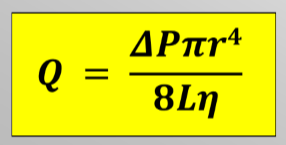
CSA
the total _______________ increases toward the periphery, thus decreasing velocity in the distal vessels
presence
direction
speed
character
Doppler provides info about flow, including:
Doppler effect
the change in frequency (and therefore wavelength) caused by motion of a sound source, receiver, or reflector
movement of the reflector
______________ will change the transmitted frequency into a different received frequency
higher
if the reflector is moving towards the receiver, the received frequency will be ______________ than the transmitted frequency
lower
if the reflector is moving away from the receiver, the received frequency will be ______________ than the transmitted frequency
Doppler shift
the difference between the frequency of the received sound wave and the frequency of the emitted sound

Doppler
this is the ____________ equation

Doppler angle
the angle between the direction of sound propagation and the flow direction
% of error in speed
as the Doppler angle increases, the ______________ also increases with each degree of angle degree error
Nyquist limit
the upper limit of Doppler shift that can be detected properly by pulsed instruments
PRF
if the Doppler shift frequency exceeds one half the __________ (aka the Nyquist limit), aliasing occurs
shift baseline
increase PRF
increase Doppler angle
use lower operating frequency
use CW
ways to correct for aliasing:
vessel length, vessel radius, and viscosity
__________________ affect resistance
temporal
steady and pulsatile flow are both _______________ flow categories
steady flow
fluid that moves at a constant speed or velocity
blood through arterioles and peripheral veins
pulsatile flow
non-steady flow with acceleration & deceleration over the cardiac cycle
fluid that moves with a variable velocity
blood through arteries, IVC, SVC
spatial
laminar, disturbed, and turbulent flow are all ____________ flow categories
laminar
___________ flow includes plug and parabolic flow
plug flow
majority of fluid travels at the same speed
occurs at the entrance to a vessel
similar to the motion of a solid object that moves as a unit
parabolic flow
average velocity = ½ max velocity in the center of the vessel
disturbed flow
streamlines persist but waver and vary
irregular pattern which is oscillatory
initial indication of laminar breakdown
caused by increased velocity and altered vessel geometry
turbulent flow
chaotic flow in many directions and speeds
streamlines are obliterated
vortex (swirling pattern of rotational flow)
flow varies from instant to instant and from location to location
flow energy converted to sound (murmurs, bruits) or vibration (thrill)
often associated with cardiovascular pathology and increased velocities
acceleration (increase in velocity)
_____________ occurs during early systole when the ventricles are rapidly ejecting blood
deceleration (decrease in velocity)
occurs during late systole (not during diastole)
tends to uniformly slow down
flow reversal
Windkessel effect
two major characteristics of pulsatile flow are:
vessel compliance
expansion and contraction of a vessel
expands; recoils
a compliant vessel ___________ with increase pressure and ____________ when the pressure drops
expansion of elastic vessels
the _____________ leads to a brief reversal of flow during diastole as the pressure distally overcomes the pressure upstream because of the heart relaxing
Windkessel effect
the contraction (recoiling) of the compliant vessel then increases the upstream pressure and adds forward flow later in the cycle
Reynold’s number
the likelihood of turbulence is expressed in terms of ______________
critical threshold
turbulence occurs when velocity exceeds a ______________
2000
a RE above _______________ indicates turbulent flow
entrance effects
at the origin of a vessel, plug flow appears
friction from the vessel walls cause streamlines on the outside to slow down
flow profiles vary at beginning of vessel in comparison to farther downstream
boundary layer separation
when a vessel suddenly widens, fluid falls toward the new vessel boundary
results in flow reversal in the small region at the vessel expansion
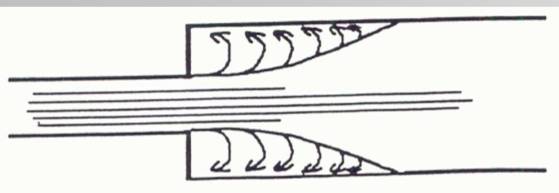
Eddy current
rotational motion from turbulent flow
referred to as a mosaic color Doppler pattern
commonly occurs distal from a stenosis
lower velocity than in stenosis
tapering
in _______________ vessels:
blunted or flattened flow (plug flow)
most of blood cells travel at the same velocity, regardless of their position within the vessel
diverging
in __________ vessels:
elongated flow profile
lamina spread out
flow is likely to destabilize
results in disturbed or turbulent flow
aorta
primary vessel of systemic circulation
arterioles
considered the regulators of flow
arterioles
in _______________, pulsatile flow patterns are abolished and converted to steady flow
high resistance
a large drop in pressure from proximal to the distal side of the arteriole indicates the arteriole’s ________________
arterioles
the highest drop in pressure occurs at the level of the ______________
mild arterial disease
often undiagnosed at rest
during periods of increased flow (exercise), the pressure drop can become noticable
severe arterial disease
can typically be diagnosed at rest
the pulsatile nature of the pressure wave is diminished downstream from the obstruction
high peripheral resistance
flow patterns with ________________:
energy stored in the distended artery is unable to overcome the high resistance downstream
flow occurs only in systole
triphasic flow patterns may result
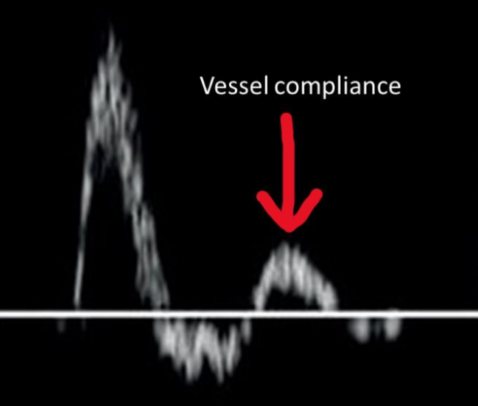
low peripheral resistance
flow patterns with _____________:
energy stored in the distended artery overcomes the low resistance downstream
forward flow occurs throughout the cardiac cycle
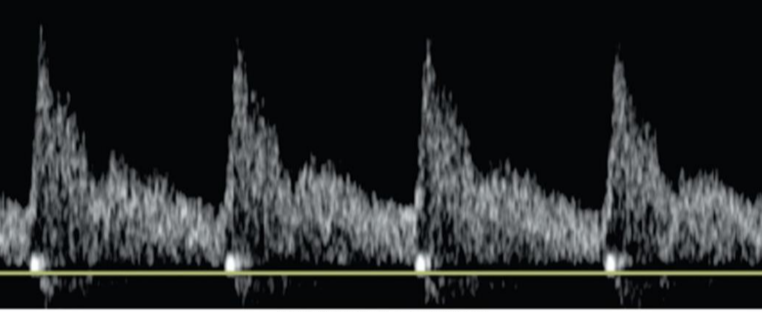
arterial obstruction (stenosis)
blockage that forms in arteries generally caused by atherosclerotic plaque
may decrease distal pressure and/or flow
occlusion
the complete blockage of a vessel without any flow around it
length and diameter of narrowing
endothelial surface
gradual or abrupt narrowing
% area reduction of orifice
flow through the obstruction
arterial-venous pressure gradient
peripheral resistance distal to stenosis
factors that determine the hemodynamic effects of arterial obstruction:
continuity rule
blood is neither created nor destroyed as it flows through a vessel
volumetric flow rate must be constant proximal, within, and distal to a stenosis
flow speed increases at stenosis to maintain a constant flow
inversely
pressure and velocity are _____________ related
Bernoulli effect
the decreased pressure in regions of high flow speed is known as the _______________
pressure drop
to allow fluid to accelerate into the stenosis, there is a _____________
increase in pressure
to allow fluid to decelerate out of a stenosis, there is an _________________
upstream
effects of a stenosis: _______________
triphasic pattern
plug flow
may demonstrate high resistance waveform
may be some turbulence
within lesion
effects of a stenosis: _______________
elevated flow velocities
decrease in pressure
possibility of some turbulence
downstream
effects of a stenosis: _______________
dampened pattern
loss of pulsatility
delayed upstroke
may demonstrate low resistance waveform
loss of triphasic waveform
turbulence, spectral broadening, murmurs and/or thrills
normal tracing of arterial pressure waveform
rapid upstroke
sharp peak
prominent dicrotic notch
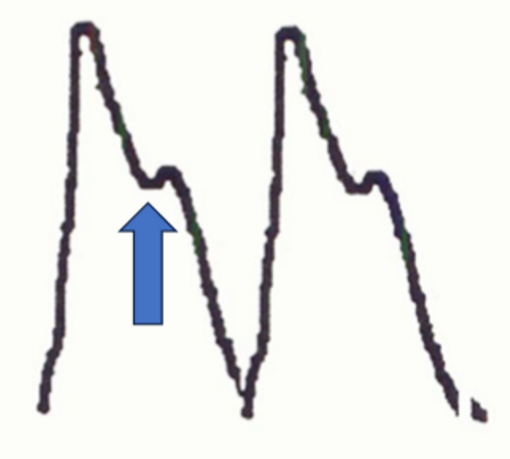
mildly abnormal arterial pressure waveform
rapid upstroke
sharp peak
absent dicrotic notch
bowed downslope

moderately abnormal arterial pressure waveform
flattened peak
upslope=downslope
absent dicrotic notch
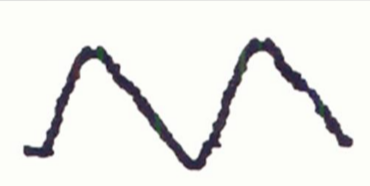
severely abnormal arterial pressure waveform
low amplitude
loss of pulsatility

series
resistances arranged in _______________:
obstructions in the same vessel, one upstream and the other downstream
resistances add—they combine to form a higher resistance than either individual lesion

parallel
resistances arranged in _____________:
obstructions in different vessels, the vessels start at the same location and end at the same location
resistances combine into a lower resistance than either individual lesion
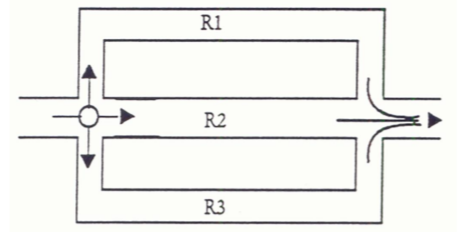
collateral vessels
the development of alternative, secondary, or accessory vascular pathways that allow extra blood to reach tissues located downstream from an occluded artery
exercise
____________ is the most potent vasodilator
perforator veins
connect the superficial and deep systems
superficial to deep
flow direction of veins is from _______________
transmural pressure
the pressure across the vessel wall
hydrostatic pressure
the weight of the blood pressing against the vessel walls
equal to the weight of the column of blood from the heart to the point of measurement
comes from gravity
zero
in a supine patient, the hydrostatic pressure is ____________
positive
below the heart, hydrostatic pressure is ______________
negative
above the heart level, hydrostatic pressure is ______________
inspiration
______________ results in increased flow from abdomen to chest
expiration
_____________ results in decreased flow from abdomen to chest
venous reflux (insufficiency)
increased venous pressure
decreased venous return
mild cases—patient must be semi-erect to document
severe cases—can also be demonstrated in supine
deep vein thrombosis (DVT)
venous stasis can cause the blood to clot (thrombus) resulting in partial or complete obstruction of the vein
reduces blood flow to the heart
increased venous volume below it
can lead to damaged valves and embolus
edema
the accumulation of abnormally large volumes of fluid in the intercellular spaces of the body
arteriovenous fistula
a direct connection between an artery and vein
a low resistance pathway
may be congenital or acquired (from trauma or surgically created)
pseudoaneurysm
vessel wall ruptures resulting in extravascular blood collection
occurs as a result of trauma, in angioaccess grafts, or at puncture sites
ying-yang color Doppler and to-and-fro Doppler pattern
the sonographic appearance of a pseudoaneurysm is:
external compression
a fresh pseudoaneurysm can be treated with ________________
ultrasound guided thrombin injection
An older pseudoaneurysm cannot be compressed due to endothelization and requires ____________________